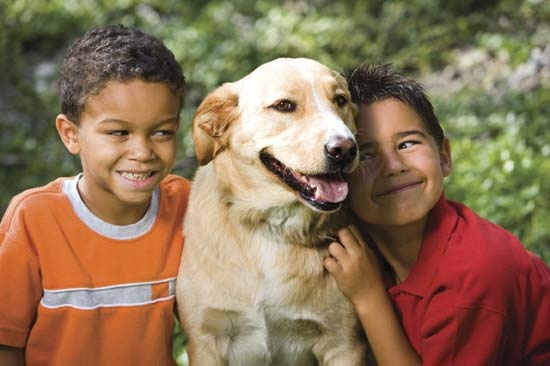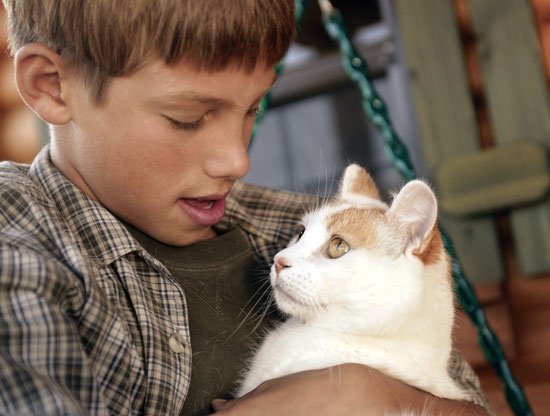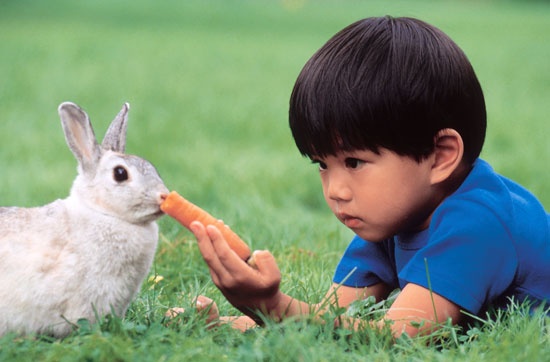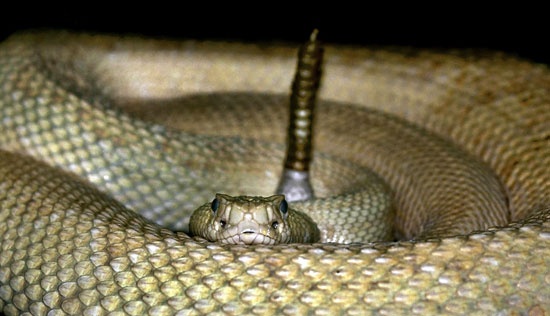pet
animal
 any animal kept by human beings as a source of companionship and pleasure.
any animal kept by human beings as a source of companionship and pleasure.While a pet is generally kept for the pleasure that it can give to its owner, often, especially with horses, dogs, and cats, as well as with some other animals, this pleasure appears to be mutual. Thus, pet keeping can be described as a symbiotic relationship, one that benefits both animals and human beings. As the keeping of pets has been practiced from prehistoric times to the present and as pets are found in nearly every culture and society, pet keeping apparently satisfies a deep, universal human need.
The history of pets is intertwined with the process of animal domestication, and it is likely that the dog, as the first domesticated species, was also the first pet. Perhaps the initial steps toward domestication were taken largely through the widespread human practice of making pets of captured young wild animals. Eventually, a working relationship developed between the dogs and their human captors. The dog was swifter, had stronger jaws, and was better at tracking prey; therefore, it could be of great use in hunting and guarding duties. From human beings, on the other hand, the dogs were assured of a constant supply of food as well as warmth from the fire. There is indirect evidence that the dog may have been domesticated and kept as a pet since Paleolithic times, as can be surmised from the paintings and carvings that archaeologists have found in ancient campsites and tombs. In Mesopotamia (Mesopotamia, history of), dogs that look remarkably like the present-day mastiff were shown participating in a lion hunt. Domestic pets were often depicted in the scenes of family life in ancient Egypt; (Egypt, ancient) hunting dogs of the greyhound or saluki type accompany their master to the chase, and lap dogs frequently sit under the chair of their master or mistress.
 Next to the dog, horses and cats are the animals most intimately associated with human beings. Surprisingly, both these animal groups were domesticated rather late in human history. There is no evidence that horses (horse) were domesticated in Paleolithic or Mesolithic times, but by about 2000 BC horses used in chariot battles were an established phenomenon throughout the Middle East. It seems that riding astride horses was a practice developed a few centuries later (see horsemanship). The cat (feline), too, does not seem to have been domesticated as a pet until the New Kingdom period (about the 16th century BC) in Egypt. This is all the more strange as the ancient Egyptians had tamed many types of animals, such as lions, hyenas, monkeys, the Nile goose, and dogs, since the Old Kingdom period. But once cats were finally domesticated, their popularity was enormous. Gradually, the cat became one of the most universally worshiped animals.
Next to the dog, horses and cats are the animals most intimately associated with human beings. Surprisingly, both these animal groups were domesticated rather late in human history. There is no evidence that horses (horse) were domesticated in Paleolithic or Mesolithic times, but by about 2000 BC horses used in chariot battles were an established phenomenon throughout the Middle East. It seems that riding astride horses was a practice developed a few centuries later (see horsemanship). The cat (feline), too, does not seem to have been domesticated as a pet until the New Kingdom period (about the 16th century BC) in Egypt. This is all the more strange as the ancient Egyptians had tamed many types of animals, such as lions, hyenas, monkeys, the Nile goose, and dogs, since the Old Kingdom period. But once cats were finally domesticated, their popularity was enormous. Gradually, the cat became one of the most universally worshiped animals.As has been noted, the primary bond distinguishing a pet-and-owner relationship is affection. As useful as many of these animals are, what differentiates a pet from other economically useful livestock is the degree of contact between the animals and human beings. Often, this relationship has been unabashedly sentimentalized in myth, art, and literature. The affection between Alexander the Great and his favourite horse, Bucephalus, has become legendary, while in the modern age the popularity of such canine motion-picture stars as Rin Tin Tin and Lassie is further evidence of the importance placed on the relationship between owner and pet.
The pet-and-owner relationship, however, is not only founded on companionship; since the earliest period of domestication, pets have fulfilled practical, economic ends. Catching other animals to feed their human masters is one of the most fundamental uses of pets, and not only dogs have served in this capacity but cats, hyenas, and lions have also been used for hunting. The aristocratic, rather arcane sport of falconry made use of the natural talent of hawks to aid in hunting game birds. Pets have also been used for the purpose of guarding—either other livestock, the home or territory of their owners, or the owners themselves. Any pet that has a sharp sense of smell or hearing and that makes a loud noise when aroused can be used as a guard, although dogs are the best-known examples. It is thought that the Nile goose, a favourite household pet of the ancient Egyptians, may have served such a purpose. The herding and guarding of livestock is another practical use of pets, in particular the dog. Over the centuries, many specialized breeds of dog have been developed to suit this purpose.
Often, pets have been used as a source of food when other sources become scarce. This has been the case with dogs throughout their history of domestication in both the Old World and the New World. Guinea pigs, domesticated as pets in the New World, also assured a stable food supply.
Pets have also been used to eliminate animal pests. The rat-catching ability of cats is celebrated in fairy tales such as “Puss 'n Boots” and “Dick Whittington,” as is the snake-catching talent of the mongoose in Rudyard Kipling's “Rikki-tikki-tavi.”
Finally, pets themselves have become a self-perpetuating industry, bred for a variety of purposes, including their value as breeding animals (animal breeding). Pets that are bred for aesthetic purposes may have full-fledged show careers. Other pets may be bred for racing or other competitive sports, around which sizable industries have been built.
 Animals kept as pets can be classified according to the type of premises or habitat they usually occupy. Dogs, cats, and birds such as canaries and parakeets are kept as household pets. Other birds, such as jays, magpies, and members of the crow family, are kept in aviaries. When kept as pets, reptiles and amphibians frequently require special conditions of heat and moisture. For this reason, they are best kept in glassed enclosures called vivaria. The most common vivarium (terrarium) pets are snakes, lizards, turtles, frogs, and toads. Many people keep fish as aquarium pets. Fishes constitute a completely separate section of the pet world, and an international industry exists for catching, breeding, transporting, and supplying stock. Hutch, or cage, pets can be kept indoors or outdoors under protected conditions. These pets include rabbits, guinea pigs, rats, mice, hamsters, gerbils, and, recently, chinchillas. Paddock pets are those that must be stabled outdoors and include such animals as horses, ponies, donkeys, and mules. Several kinds of insects are also kept as pets. These include walking-stick insects (kept in simple containers at room temperature) and ants (kept in artificial nests).
Animals kept as pets can be classified according to the type of premises or habitat they usually occupy. Dogs, cats, and birds such as canaries and parakeets are kept as household pets. Other birds, such as jays, magpies, and members of the crow family, are kept in aviaries. When kept as pets, reptiles and amphibians frequently require special conditions of heat and moisture. For this reason, they are best kept in glassed enclosures called vivaria. The most common vivarium (terrarium) pets are snakes, lizards, turtles, frogs, and toads. Many people keep fish as aquarium pets. Fishes constitute a completely separate section of the pet world, and an international industry exists for catching, breeding, transporting, and supplying stock. Hutch, or cage, pets can be kept indoors or outdoors under protected conditions. These pets include rabbits, guinea pigs, rats, mice, hamsters, gerbils, and, recently, chinchillas. Paddock pets are those that must be stabled outdoors and include such animals as horses, ponies, donkeys, and mules. Several kinds of insects are also kept as pets. These include walking-stick insects (kept in simple containers at room temperature) and ants (kept in artificial nests). Of increasing concern is the sale of exotic pets (e.g., jaguars, alligators, ocelots, monkeys, apes, kinkajous, etc.). Rarely are the owners of such pets able to provide the basic nutritional or habitat needs of these animals; most of the animals soon die or are sent to a zoo. Furthermore, in order to obtain the young, which are considered most desirable as pets, many adults of the wild species are killed, seriously depleting populations already endangered. Several countries have passed laws to prohibit the importation of endangered species as pets, but an active black market flourishes.
Of increasing concern is the sale of exotic pets (e.g., jaguars, alligators, ocelots, monkeys, apes, kinkajous, etc.). Rarely are the owners of such pets able to provide the basic nutritional or habitat needs of these animals; most of the animals soon die or are sent to a zoo. Furthermore, in order to obtain the young, which are considered most desirable as pets, many adults of the wild species are killed, seriously depleting populations already endangered. Several countries have passed laws to prohibit the importation of endangered species as pets, but an active black market flourishes.- Frontinus, Sextus Julius
- Fronto, Marcus Cornelius
- Front Range
- Frosinone
- frost
- Frost, A.B.
- frostbite
- frosted bat
- Frost, John
- frost point
- Frost, Robert
- Vincent d' Indy
- Vincent du Vigneaud
- Vincente Minnelli
- Vincent Ferrer, Saint
- Vincent, Gene
- Vincent gingivitis
- Vincentian
- Vincent Joseph Schaefer
- Vincent Massey
- Vincent Novello
- Vincent Of Beauvais
- Vincent of Lérins, Saint
- Vincent Persichetti
- Vincent Price